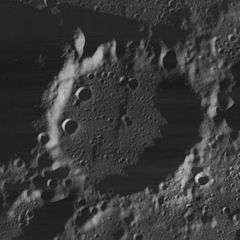Gioja (crater)
|
Lunar Orbiter 4 image | |
| Coordinates | 83°18′N 2°00′E / 83.3°N 2.0°ECoordinates: 83°18′N 2°00′E / 83.3°N 2.0°E |
|---|---|
| Diameter | 41 km |
| Depth | 2.9 km |
| Colongitude | 4° at sunrise |
| Eponym | Flavio Gioia |
Gioia is a lunar crater that is located in the vicinity of the north pole of the Moon. It is named after the Italian inventor Flavio Gioia. As it lies so close to the northern limb, it is viewed nearly from the edge making difficult to observe from the Earth. The crater is attached to the southern rim of the larger Byrd, a formation with low walls. To the south-southeast is the crater Main.
The rim of Gioia remains nearly circular, but is worn and somewhat eroded. The exterior ramparts have been modified by subsequent impacts, particularly along the western rim. The rim achieves its high point to the northwest, where it has been reinforced by the rim of the crater Byrd and other since-vanished formations. The interior floor is nearly flat, with a low cleft or ridge running from the midpoint to the north-northeast rim. Several tiny craterlets mark the inner floor, most notably a pair near the west-northwestern inner wall.
External links
- LAC-1 area - Map of northern lunar pole
References
- Andersson, L. E.; Whitaker, E. A. (1982). NASA Catalogue of Lunar Nomenclature. NASA RP-1097.
- Blue, Jennifer (July 25, 2007). "Gazetteer of Planetary Nomenclature". USGS. Retrieved 2007-08-05.
- Bussey, B.; Spudis, P. (2004). The Clementine Atlas of the Moon. New York: Cambridge University Press. ISBN 978-0-521-81528-4.
- Cocks, Elijah E.; Cocks, Josiah C. (1995). Who's Who on the Moon: A Biographical Dictionary of Lunar Nomenclature. Tudor Publishers. ISBN 978-0-936389-27-1.
- McDowell, Jonathan (July 15, 2007). "Lunar Nomenclature". Jonathan's Space Report. Retrieved 2007-10-24.
- Menzel, D. H.; Minnaert, M.; Levin, B.; Dollfus, A.; Bell, B. (1971). "Report on Lunar Nomenclature by the Working Group of Commission 17 of the IAU". Space Science Reviews. 12 (2): 136–186. Bibcode:1971SSRv...12..136M. doi:10.1007/BF00171763.
- Moore, Patrick (2001). On the Moon. Sterling Publishing Co. ISBN 978-0-304-35469-6.
- Price, Fred W. (1988). The Moon Observer's Handbook. Cambridge University Press. ISBN 978-0-521-33500-3.
- Rükl, Antonín (1990). Atlas of the Moon. Kalmbach Books. ISBN 978-0-913135-17-4.
- Webb, Rev. T. W. (1962). Celestial Objects for Common Telescopes (6th revised ed.). Dover. ISBN 978-0-486-20917-3.
- Whitaker, Ewen A. (1999). Mapping and Naming the Moon. Cambridge University Press. ISBN 978-0-521-62248-6.
- Wlasuk, Peter T. (2000). Observing the Moon. Springer. ISBN 978-1-85233-193-1.
